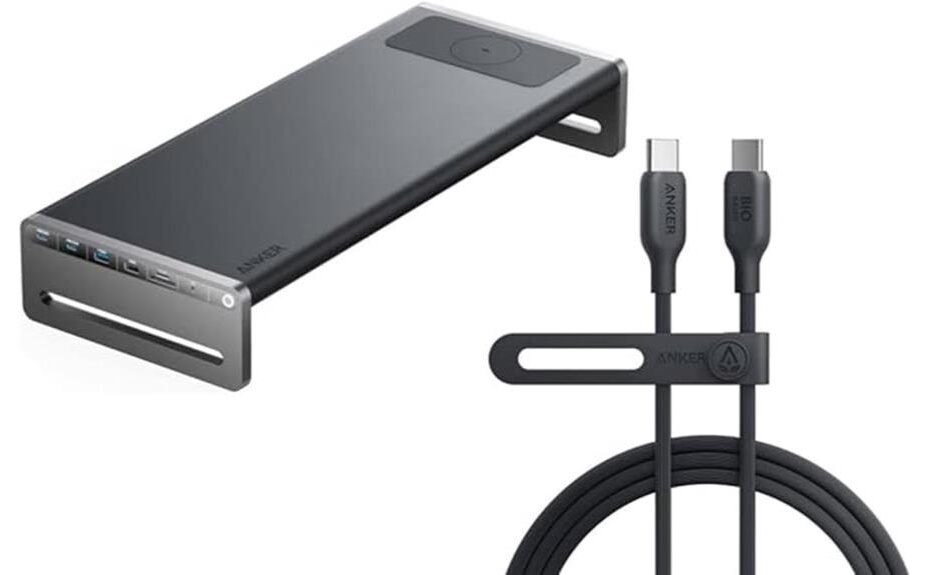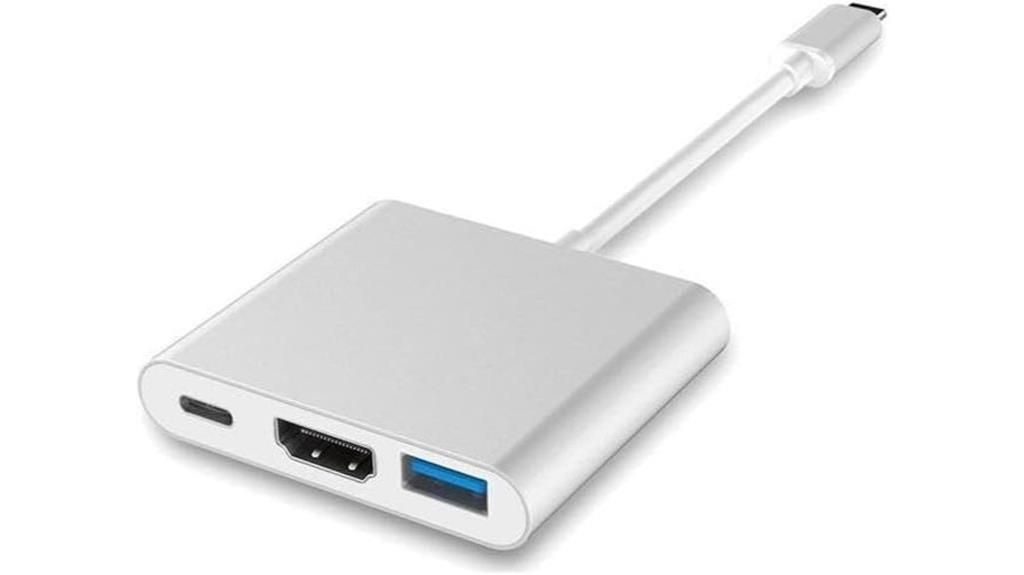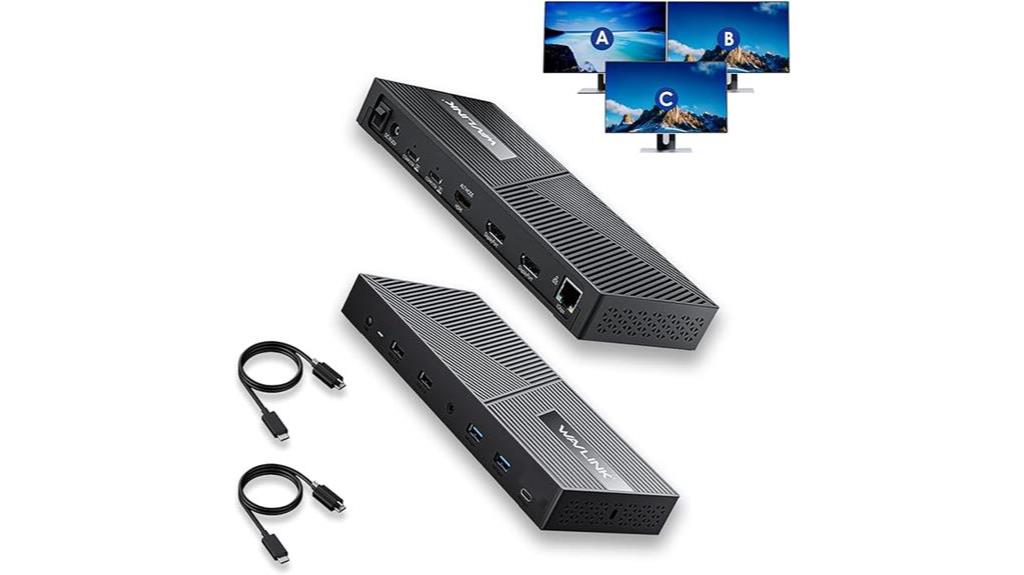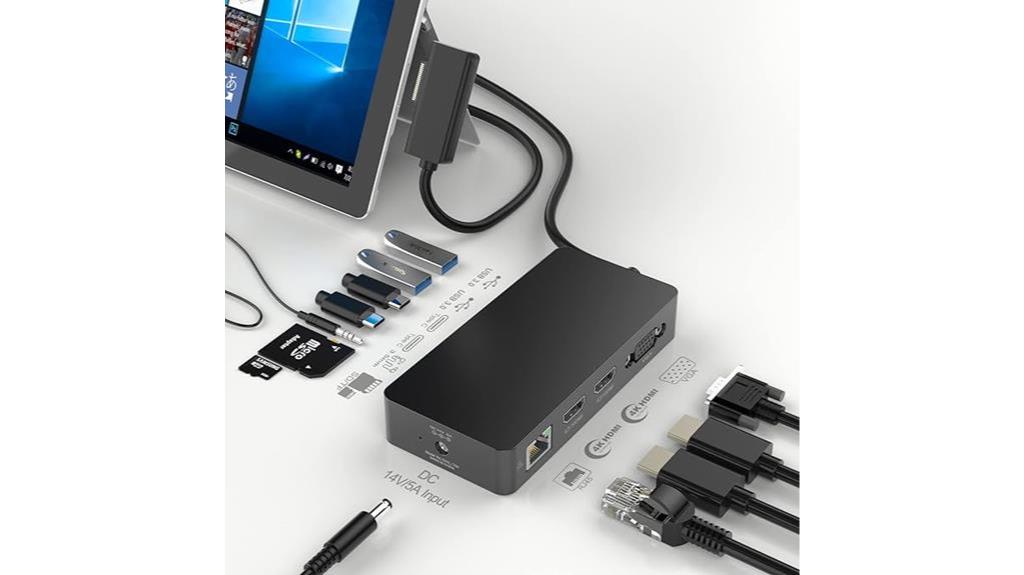



The Anker 543 Cable and 675 Docking Station offer robust performance and eco-friendly design. The 543 Cable features a 6-foot length, delivers up to 140W power, and boasts a 20,000-bend lifespan, ensuring durability. Meanwhile, the 675 Docking Station excels with 12-in-1 functionality, supporting 4K@60Hz output and 10Gbps data transfer speeds. Ideal for professionals and tech enthusiasts, these products enhance workspace organization while promoting sustainability. Although some users report minor cable compatibility issues and the size of the docking station as potential drawbacks, overall satisfaction remains high. To discover further insights and recommendations, continue on to explore more details.
Key Takeaways
- The Anker 543 Cable features a 20,000-bend lifespan and delivers up to 140W for versatile charging needs.
- Anker 675 Docking Station offers 12-in-1 connectivity, including 4K@60Hz HDMI output and 10Gbps data transfer speeds.
- Both products utilize eco-friendly materials, addressing sustainability in tech manufacturing.
- Positive customer feedback highlights the cable's durability and the docking station's versatility, though some users noted compatibility issues with older devices.
- The docking station enhances workspace organization with integrated cable management and multiple peripheral connectivity options.
In the domain of modern connectivity solutions, the Anker 543 USB C to USB C Cable stands out as a significant advancement in charging technology. This cable, designed with eco-friendly technology, utilizes bio-based materials derived from renewable sources such as corn and sugar cane, addressing sustainability concerns prevalent in today's market. With the growing demand for versatile accessories, the cable complements products like the WALNEW USB C Hub that enhance device connectivity. Its robust construction and 20,000-bend lifespan cater to diverse usage scenarios, from everyday charging of smartphones and laptops to more demanding applications requiring high-speed data transfer. The cable's capacity to deliver up to 140W guarantees compatibility with a wide range of devices, making it a versatile tool for consumers seeking efficiency and environmental responsibility in their technology choices. Overall, the Anker 543 cable exemplifies a blend of performance and sustainability.
Features and Benefits
The Anker 543 Cable and 675 Docking Station offer a range of features designed to enhance user experience and functionality. The bio-based construction of the cable underscores Anker's commitment to sustainability while providing robust performance, including 10Gbps data transfer speeds. Additionally, the docking station's wireless charging capability and versatile connectivity options facilitate seamless integration of multiple devices, promoting an organized workspace.
Bio-Based Cable Construction
Anker's innovative approach to cable construction is exemplified by the 543 USB-C to USB-C cable, which incorporates bio-based materials derived from renewable resources such as corn and sugar cane. This use of eco-friendly materials not only enhances the cable's sustainability profile but also contributes to a reduction in reliance on petroleum-based plastics. The cable's durable design allows for a remarkable 20,000-bend lifespan, ensuring longevity alongside its environmental benefits. By integrating bio-based components, Anker addresses consumer demand for sustainable technology solutions, making it a responsible choice for environmentally-conscious users. This commitment to sustainability benefits not only the end-user but also contributes positively to the broader ecosystem, reflecting an essential shift towards greener manufacturing practices in the tech industry.
2-in-1 Connectivity Options
While many docking stations offer basic connectivity, the Anker 675 USB-C Docking Station distinguishes itself with its extensive 12-in-1 connectivity options, catering to a diverse range of user needs. This docking station embodies multi-port versatility, featuring a combination of USB-C and USB-A ports, HDMI outputs, and a wireless charging pad, all designed to facilitate seamless integration into various work environments. Users can connect multiple peripherals simultaneously, enhancing productivity without sacrificing performance. The docking station supports 4K video output at 60Hz, ensuring high-quality display capabilities. In addition, it provides ample power delivery, allowing devices to charge efficiently while in use. This thorough connectivity solution positions the Anker 675 as an essential accessory for modern professionals.
Wireless Charging for Devices
Incorporating wireless charging capabilities into the Anker 675 USB-C Docking Station profoundly enhances its functionality and user experience. This feature provides notable charging convenience, allowing users to power compatible devices effortlessly by simply placing them on the integrated charging pad. The design not only promotes wireless efficiency but also declutters the workspace by eliminating the need for additional cables. Users can charge their smartphones or other Qi-enabled devices while simultaneously utilizing multiple ports for data transfer and power. This dual functionality allows for an organized and streamlined environment, catering to the demands of modern multitasking. Overall, the wireless charging feature greatly contributes to the docking station's appeal, making it an essential tool for users seeking enhanced productivity.
0Gbps Data Transfer Speed
As data transfer needs continue to escalate in both professional and personal environments, the Anker 675 USB-C Docking Station meets these demands by offering impressive 10Gbps data transfer speeds across its USB-C ports. This high-speed capability facilitates rapid file transfers, making it suitable for users who regularly handle large multimedia files or require efficient data synchronization. In speed comparisons with standard USB 3.0 connections, which typically offer up to 5Gbps, the Anker 675 effectively doubles the potential throughput. Such performance not only enhances productivity but also minimizes wait times, fostering a seamless workflow. Overall, the docking station's robust data transfer speeds greatly contribute to its appeal as an essential tool for modern tech users seeking peak efficiency.
Product Quality
Evaluating the product quality of the Anker 543 Cable and 675 Docking Station reveals a commitment to durability and functionality. The cable's exterior, crafted from bio-based materials, undergoes rigorous durability testing, boasting a remarkable 20,000-bend lifespan. This highlights Anker's intention to create sustainable yet robust products suitable for everyday use. In addition, the docking station's design reflects versatility, accommodating various peripherals while ensuring stability. Customer satisfaction is evident, as users appreciate the reliable performance and innovative features, such as the 100W USB-C upstream port and multi-device connectivity. Overall, the careful selection of materials and thoughtful engineering contribute greatly to the perceived quality, making the Anker 543 and 675 an attractive option for consumers seeking longevity and efficiency.
What It's Used For
The Anker 543 Cable and 675 Docking Station are designed to enhance productivity through their fast charging capabilities, facilitating efficient power delivery to multiple devices simultaneously. The docking station's multi-device connectivity guarantees seamless integration of peripherals, while its organizational features promote a clutter-free workspace. Together, these products serve as all-encompassing solutions for users seeking to optimize their electronic setups.
Fast Charging Capabilities
With a robust 140W output, the Anker 543 USB C to USB C Cable is engineered to facilitate rapid charging for a variety of devices, including laptops, tablets, and smartphones. This cable utilizes Power Delivery technology, allowing it to efficiently transfer higher wattage levels compared to standard cables. Such capabilities make it particularly valuable for users who require quick charging solutions, enabling devices to reach ideal power levels in greatly reduced timeframes. The cable's design supports fast charging protocols, ensuring compatibility with a wide range of modern electronics. This efficiency is especially critical in professional environments where time is of the essence, providing seamless power solutions that enhance productivity without sacrificing performance.
Multi-Device Connectivity
How effectively can a single docking station manage multiple devices simultaneously? The Anker 675 Docking Station excels in multi-device connectivity, offering 12 ports that facilitate seamless integration of various peripherals. With support for USB-C and USB-A connections, it demonstrates broad device compatibility, accommodating laptops, smartphones, and other accessories without compromise. Users can establish simultaneous connections to external displays, storage devices, and charging stations, enhancing productivity in a single workspace.
Furthermore, the docking station's 10Gbps USB-C ports guarantee rapid data transfer rates, essential for users requiring efficient performance across multiple devices. This capability allows for a streamlined workflow, minimizing the clutter of excessive cables while maximizing functionality, making it an ideal choice for professionals in need of versatile connectivity solutions.
Workspace Organization Solutions
Anker's 675 Docking Station not only enhances multi-device connectivity but also greatly contributes to workspace organization. By serving as an all-in-one workspace organizer, it supports a monitor while providing ample storage for keyboards, mice, and other peripherals beneath. This design notably improves workspace efficiency by reducing clutter and maximizing available desk space. Additionally, the docking station's integrated cable management system effectively organizes various cables, preventing tangles and promoting a clean aesthetic. The docking station features multiple ports, allowing for easy access to devices without the hassle of excessive wiring. Overall, the Anker 675 Docking Station is a practical solution for those seeking an organized and efficient workspace, facilitating both productivity and aesthetic appeal.
Product Specifications
Examining the product specifications reveals the robust capabilities of both the Anker 543 USB C to USB C Cable and the Anker 675 USB-C Docking Station. The Anker 543 cable measures 6 feet in length and is designed for a power delivery of up to 140W, ensuring compatibility with a wide range of devices. Its bio-based material construction contributes to its durability, boasting a lifespan of 20,000 bends. The docking station offers a versatile 12-in-1 functionality with several ports for connectivity.
| Feature | Anker 543 USB C Cable | Anker 675 USB-C Docking Station |
|---|---|---|
| Product Dimensions | 6 ft | N/A |
| Cable Compatibility | USB 2.0 | USB-C |
| Maximum Power Delivery | 140W | 100W (upstream) |
| Data Transfer Speed | 10Gbps | 10Gbps |
| HDMI Resolution | N/A | 4K@60Hz |
Who Needs This
The robust specifications of the Anker 543 USB C to USB C Cable and the Anker 675 USB-C Docking Station make them suitable for a wide range of users. Creative professionals, such as graphic designers and video editors, will benefit from the high data transfer speeds and 4K display capabilities, enabling seamless workflow and high-resolution content output. Additionally, tech enthusiasts will appreciate the versatility of the 12-in-1 docking station, which offers multiple connectivity options and efficient organization of workspace peripherals. With features that support high-performance tasks, like those found in the MINISFORUM Venus UM790 Pro, users can expect peak efficiency in their setups. The durable design of the cable, coupled with its bio-based materials, aligns with environmentally conscious users. Overall, these products cater to individuals who seek performance, efficiency, and sustainable technology in their daily tasks.
Pros
Highlighting the strengths of the Anker 543 USB C to USB C Cable and the Anker 675 USB-C Docking Station reveals a range of benefits that enhance user experience. The thoughtful design aesthetics of both products not only contribute to functionality but also elevate workspace organization, making them visually appealing as well. The cable's performance is complemented by enhanced connectivity features similar to those found in the Amazon Basics HDMI cable, guaranteeing reliable connections across devices.
- Exceptional durability with a 20,000-bend lifespan guarantees longevity.
- The docking station's 12-in-1 capabilities streamline productivity while minimizing clutter.
- Eco-friendly materials used in the cable resonate with environmentally conscious users.
These features combine to create an efficient and aesthetically pleasing work environment, while the performance specifications, including 10Gbps transfer speeds and 4K@60Hz support, further solidify their value in modern computing setups.
Cons
Despite the numerous advantages offered by the Anker 543 USB C to USB C Cable and the Anker 675 USB-C Docking Station, there are several drawbacks that potential users should consider.
- Cable compatibility issues may arise with certain older devices.
- The docking station limitations include a lack of Ethernet ports, which can hinder network connectivity for some users.
- The wireless charging pad may not support all phone models, potentially leading to frustration.
These drawbacks could impact the overall user experience, particularly for those who rely on seamless connectivity and robust performance. In this regard, it's essential for prospective buyers to evaluate these limitations against their specific needs and device compatibility before making a purchase decision.
What Customers Are Saying
Customer feedback plays a significant role in understanding the real-world applications and limitations of the Anker 543 USB C to USB C Cable and the Anker 675 USB-C Docking Station. Customer insights reveal a high level of satisfaction with the durability and performance of the cable, particularly its robust construction and fast charging capabilities. Users consistently report positive experiences with the docking station's versatility, commending its multiple ports and 4K display support. However, some customers express concerns regarding the wireless charging pad's effectiveness and the docking station's size, which may not suit all desk setups. Overall, user experiences highlight both the strengths and minor shortcomings of these products, providing valuable context for potential buyers.
Overall Value
When evaluating the overall value of the Anker 543 USB C to USB C Cable and the Anker 675 USB-C Docking Station, it is essential to contemplate their performance, features, and price in relation to competitors. The 543 cable offers robust specifications, including 140W charging capability and a durable design, enhancing user experience by ensuring reliability and longevity. Meanwhile, the 675 docking station provides extensive connectivity options, including 4K display support and wireless charging, which cater to a diverse range of user needs. Market comparison reveals that while both products may be priced slightly higher than some alternatives, the superior build quality and extensive functionality justify the investment. Consequently, these products represent a strong overall value for consumers seeking dependable and versatile tech solutions.
Tips and Tricks For Best Results
To maximize the performance of the Anker 543 USB C to USB C Cable and the Anker 675 USB-C Docking Station, users should consider several key practices. First, identify ideal usage scenarios; for instance, using the docking station to connect multiple peripherals enhances productivity in a home or office setup. Additionally, make certain that the cable is compatible with devices requiring high power delivery to fully utilize its 140W capacity. Effective cable management can also improve the overall setup; organizing cables not only reduces clutter but also minimizes wear on the cable, extending its lifespan. Finally, regularly check for firmware updates to maintain compatibility and performance with connected devices, guaranteeing the best user experience.
Conclusion
To summarize, the Anker 543 USB C to USB C Cable and the Anker 675 USB-C Docking Station exemplify innovation in connectivity and workspace organization. The user experience is greatly enhanced by the cable's robust design and the docking station's multifunctionality, allowing seamless integration into modern work environments. Additionally, the inclusion of bio-based materials in the cable construction reflects a commendable focus on reducing environmental impact, aligning with contemporary sustainability goals. Both products not only provide high-performance specifications—such as 10Gbps transfer speeds and 4K display capabilities—but also prioritize user convenience with features like wireless charging. Overall, Anker successfully combines functionality with eco-friendly practices, making these products a valuable addition to any tech setup.
Frequently Asked Questions
Is the Anker 543 Cable Compatible With All USB-C Devices?
The Anker 543 cable demonstrates impressive performance and USB-C versatility, making it compatible with a wide range of USB-C devices. However, users should verify specific device requirements to confirm ideal functionality and charging efficiency.
Can the Docking Station Support Dual Monitors?
The docking station indeed supports dual monitors, allowing users to create an efficient monitor setup. It provides 4K@60Hz display resolution, enabling enhanced productivity through seamless multi-display functionality for various applications and tasks.
How Long Is the Warranty Period for These Products?
The warranty details for these products typically reflect their reliability, offering customers peace of mind. Such warranties are essential for evaluating long-term product performance, ensuring that any defects or issues can be addressed effectively.
Are There Any Known Compatibility Issues With Specific Brands?
Ironically, despite extensive compatibility testing, some users report brand performance issues with specific devices. Such discrepancies underscore the importance of verifying compatibility before investment, highlighting the intricate relationship between hardware and functionality in modern technology.
What Are the Maintenance Requirements for the Cable and Docking Station?
Maintenance requirements for ideal cable longevity include proper storage and avoiding excessive bending. For docking station care, guarantee regular cleaning of ports and surfaces, along with periodic firmware updates to maintain performance and compatibility.
Disclosure: As an Amazon Associate, I earn from qualifying purchases.




